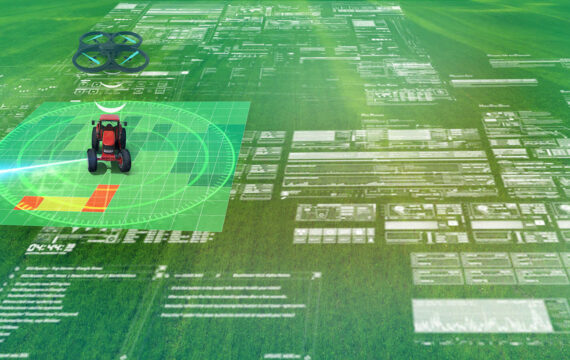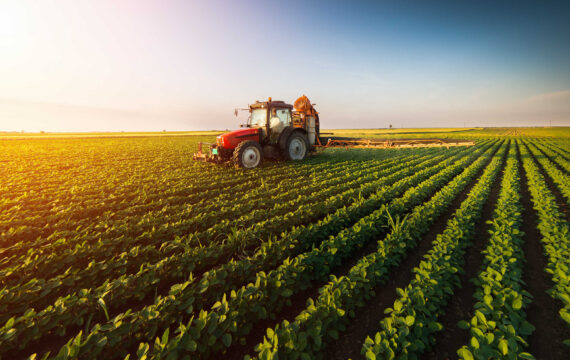Over-spraying herbicides puts pressing challenges on the agriculture industry. Farmers spend $25 billion per year buying 3 billion pounds of herbicides. But a huge volume of these chemicals never reaches weeds. Rather, it lands on soil or healthy plants or is carried away with rainwater. Applying conventional spraying technology, farmers lose money on herbicides that are sprayed in vain. Furthermore, these chemicals contaminate the soil, harming the environment; meanwhile, the weeds themselves develop herbicide resistance.
The reason for this inefficiency lies in the poor precision of broadcast sprayers. AgriTech providers claim that smart spraying technology can lower the costs of herbicides by 90% due to selective application on weeds only. Some of the most prominent technologies enabling farmers to advance from broadcast to smart spraying are GPS guidance, machine learning algorithms, and computer vision for weed recognition.
To help agribusinesses save money and the environment, let’s figure out how advanced technologies can shape smart spraying solutions for sustainable, precise, and cost-efficient herbicide application.
What’s inside:
- The main challenges for precise herbicide application and smart spraying technology
- From old-fashioned broadcasting to selective spraying technology
- Available smart spraying solutions
- Technologies required to build smart spraying solutions
Main challenges for precise herbicide application
Applying a legacy approach, farmers face four main challenges that affect herbicide application. Technological advancements can address these challenges both before and during spraying.
Ignorance of herbicide risks
Often, farmers cannot fully assess the risks related to herbicide application. Fields may be located near public objects while wind, rain, and groundwater can spread chemicals to a wider area, harming the environment. Providers of herbicides for agribusinesses can contribute to sustainable use of their products at the earliest stages — even before they sell chemicals to farmers.
Solution: Risk assessment systems that rely on dynamic in-field data, field topography heat maps, and locations of nearby objects can recommend per-field spraying plans and adjust the herbicide selling strategy. Smart spraying technology will allow farmers to evaluate the conditions of fields and the potential risks for the entire ecosystem, including the risks of landslides, groundwater contamination, and the draining of natural resources.
Delayed spraying
The best time to apply herbicides is when the weed canopy is still developing. At this stage, the lethal dosage for weeds is lower. On the contrary, late application increases the risk of herbicides being sprayed only on the canopy without reaching the bottom. This lowers the effectiveness of spraying, as weeds receive non-lethal doses of herbicides.
Solution: Timely application of herbicides on weeds can be achieved through precision mapping and data analytics. Collecting field images using drones and applying algorithms for weed recognition can help with planning spraying at the early stages of weed development, while mapping technologies can assist in the accurate distribution of herbicides on each field for efficient spraying.
In-field turns
While spraying fields, machinery makes turns, lowering the vehicle speed while the flow of chemicals stays the same. This causes over-dosing for weeds growing where turns happen. Considering that sprayers commonly move along the same routes each time they’re in the field, the same spots will receive excessive doses year after year.
Solution: GPS guidance for agricultural machinery isn’t a new concept. But correlating steering and fluid flow could be the next big thing in AgriTech. For example, John Deere’s ExactApply provides an intelligent nozzle system governed by GPS for immediate response with relevant dosing at each turn in the field.
Real-time weed recognition
Even accurate planning of weed spraying cannot save soil and healthy plants from receiving herbicides. A broadcast sprayer spreads a continuous flow of chemicals in its working range on all plants, weeds or not. The window of time for a smart sprayer to recognize a weed and spray it while moving is around 300 milliseconds. It should happen in the blink of an eye.
Solution: One of the most promising solutions for smart spraying is the real-time recognition of weeds. Computer vision and object detection play a crucial role in this process, which works as follows: a camera captures images of the spraying area, an artificial intelligence (AI) engine detects weeds, and a nozzle receives a signal to spray only a particular amount of chemicals on a precisely determined spot right in time when the sprayer reaches the weed.
From old-fashioned broadcast spraying to selective spraying technology
AgriTech companies agree that the legacy approach of spraying weeds with broadcast sprayers requires significant adjustments. Growers want to advance time-tested equipment with software technologies that can increase the precision of spraying.
The technologies that contribute most to increasing spraying precision are GPS autosteering and guidance, automated control of the boom height for changing terrain, and pulse modulation to adjust dosages in accordance with intelligent sprayer speed.
How smart spraying solutions work

Source: Bosch — Smart spraying for precise herbicide application
Computer vision and data analytics are at the heart of selective spraying in agriculture. These technologies help spraying equipment distinguish between types of foliage, recognizing weeds and provoking data-driven actions. Using AI and computer vision, the process of smart spraying consists of three main stages.
Stage 1 — Find and define
Smart sprayers equipped with cameras can capture real time images of the spraying area in the field. Trained on input examples of what weeds look like, machine learning algorithms can identify weeds in images and label them as targets for spraying.

In addition, farm spraying algorithms can distinguish between plants, exclude empty soil from the spraying range, and even label specific parameters of a weed like its sort or canopy stage.

Stage 2 — Decide and act
As soon as a camera captures an image and AI analyzes it for the presence of weeds, robotic nozzles target those weeds with high precision and spray a herbicide dose that’s adequate for the weed’s size and age. Just as an inkjet printer applies ink only to targeted points and in specific colors while avoiding white spaces, farm spraying technology applies herbicides only to targeted plants with precise dosages and avoids areas of open soil.

Stage 3 — Analyze and improve
Selective spraying can reduce the use of chemicals and potentially cut the global annual consumption of herbicides by up to 2.5 billion pounds. Analytics that complement smart spraying solutions can show farmers the exact amount of product used to calculate cost savings.

Smart sprayer technology can lead to remarkable savings. The average annual savings for a farmer may range from $150,000 to $200,000 and pay off the cost of installation in two years for a 10,000-acre farm.
Available smart spraying solutions
Bosch — Smart spraying for precise herbicide application
Bosch says that herbicides can save yields and contribute to solving the challenge of feeding almost twice the current global population. At the same time, Bosch aims to reinvent agricultural machinery for farm spraying. Their intelligent spraying software for herbicide recognition covers the entire spraying operation, from recording images to selecting a herbicide type for each weed.
Blue River Technology — Optimizing every plant
Blue River has introduced next-generation equipment for spraying in agriculture that’s adjusted with See & Spray technology. The company promises to give farmers a new way to control herbicide use and prevent herbicide resistance among weeds. They highlight the cost efficiency of their smart spraying solution, which they claim can eliminate 90% of the herbicide volume farmers spray today.
Greeneye Technology – Spray less, grow more
Greeneye applies AI and deep learning technologies to reinvent the herbicide application process by shifting from broadcast spraying with a lot of herbicide waste to precise and selective farming spray solutions. Their product for intelligent spraying in agriculture is designed to decrease the use of herbicides that cause soil and water contamination and to solve the issue of herbicide resistance while saving healthy plants from spraying-related risks.
Technologies required to build smart spraying solutions
Apart from building market-ready smart spray solutions, companies who offer targeted AgriTech expertise can contribute to smart spraying technology in several ways:
- Structuring and processing field data — As data flows increase year after year, farmers have a hard time dealing with all their data on their own. Farming software companies can simplify communication between different traditional and vertical farming systems by structuring data and preparing it for the specific task for which it will be used.
- Designing and training AI algorithms — Agriculture software companies can build machine learning models on extensive structured data sets, performing all the backstage work for spraying in agriculture. AI-based farming management systems can plan spraying at an optimal time when weeds are at the early stages of canopy development as well as quickly analyze new images to recognize weeds among other plants.
- Mapping and tracking of spraying areas — Agricultural machinery relies on GPS to complete most critical field tasks. For smart spraying, field maps are required to efficiently distribute workers and transport machinery to fields that need to be sprayed.
- Integrating spraying with farm management systems — Apart from direct factors influencing the spraying of weeds, important factors such as rain and landscape influence the way chemicals are spread in the environment. Integrating intelligent spraying technology with systems that provide contextual data for weather analytics and determining terrain limitations for spraying can help smart spraying solutions avoid hidden risks.
Final word
Smart spraying technology can save money for farmers and agribusinesses by avoiding overspending on wasted herbicides as a result of broadcast spraying. Apart from predictable and increased ROI, smart spraying can prevent harmful doses of chemicals being sprayed on fields and spread around the environment.
Herbicides are essential for increasing farming productivity to feed a growing population. Still, their use should be controlled. Smart farm spraying software along with a sustainability mindset can contribute to agricultural companies producing and selling chemicals wisely and assessing all herbicide-related risks.
Contact Intellias AgriTech experts if you plan to develop a new smart spraying solution or are already developing one and need engineering capabilities or expert advice. We’d be pleased to hear from you.




